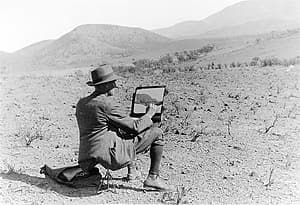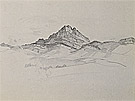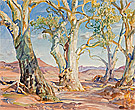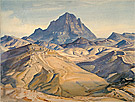The Flinders Ranges
everything looks so old that it belongs to a different world … Fine big simple forms against clear transparent skies—& a sense of spaciousness everywhere.
(Hans Heysen, 1926)
In 1926, at the age of forty-nine and already well established, Heysen went north into the Flinders Ranges. The ‘Far North’ of South Australia, beginning only 400 kilometres from Adelaide, is a long way short of Alice Springs. Between 1926 and 1933 Heysen made nine trips to the Flinders Ranges, with two further excursions in 1947 and 1949.
It is a fascinating part of our country distinct from anything in Australia, and it is crying out to be painted. No one that I know of has attempted it.
(Hans Heysen, 1927)
Heysen was the first artist to exhaustively study this landscape, as opposed to making topographical drawings and watercolours. His visits coincided with drought seasons. The bare, dry Flinders Ranges provided a new subject matter, entirely different from the Adelaide Hills agricultural landscapes and the studies of gum trees that had previously dominated his work.
Heysen sensed the need for a new approach, and reformed his style and techniques. He adopted simplified forms and strong colours in his paintings. They were more modernist works, introducing a new awareness of the diversity of the Australian landscape. He considered his Flinders landscapes some of the finest paintings he had made.
A new landscape: strategies and techniques
Heysen first recorded impressions of his subject on the spot, on his sketchboard—in either charcoal, pencil, chalk or ink, and sometimes watercolour—while seated outdoors on a stool. These sketches were mostly used as studies for future reference, to be worked on later in the studio.
He could not use the same colours in the north as he had used in the Adelaide Hills:
it needed a different blue altogether, very different … And of course the red and yellow ochres are the dominant warm colour. And the bronzes, you have to get the bronzes by mixing. Burnt sienna is an important colour too. Partly red.

F.A.Joyner, Heysen in the Flinders 1927 bromide photograph,
Art Gallery of South Australia,
Adelaide, gift of Mrs Max Joyner 1981.
Watercolour was the most suitable medium to capture the arid characteristics of the Flinders Ranges. Apart from the fact that oils were too messy, they did not do justice to the harsh, dry atmosphere. Heysen felt that the transparency and luminosity of watercolour gave the most accurate representation of the light. But this was no easy task:
it is so difficult to paint clear space—by clear I mean there is no thickness of atmosphere between you and objects, and also the circumstance under which one has to paint—heat, wind & millions of flies—is most trying.
(Hans Heysen, 1926)











